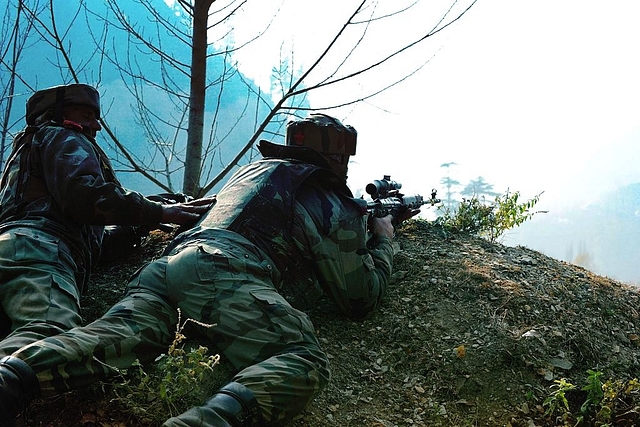
‘At Point Blank Range’: A Blow-By-Blow Account Of The Firefight In Which Five Indian Special Forces Men Died Fighting Terrorists
How Special Forces soldiers laid down their lives fighting terrorists who had infiltrated from the Pakistan-occupied side of Kashmir.
As India battled a spurt in the number of Covid-19 positive cases last week, another battle was raging near the Line of Control (LoC) in Kashmir’s Keran sector. It ended on Sunday (5 April) with the elimination of five terrorists.
A group of terrorists had infiltrated from the Pakistan-occupied side of Kashmir on Wednesday (1 April). Their movement was observed by the Indian forces near the LoC fence in drone imagery, and was later confirmed on the ground by their footprints.
The same day, India sent a search party that had soldiers from the 8 Jat Regiment. The troops briefly engaged the terrorists but they fled from their hideout, leaving behind their bags containing ammunition.
The next day, on 2 April, soldiers from 41 and 57 Rashtriya Rifles joined the operation. The Indian forces were able to engage the terrorists at around 4.30pm that day. There was heavy firing, but the terrorists managed to escape from their position again.
Indian troops managed to engage the terrorists twice on 3 April and 4 April. This is the point where commandos belonging to India’s Special Forces were brought in.
On 4 April, defence blog Livefist reported that India deployed two squads of the 4 Para (Special Forces) “for a forward staging to the nearest battalion headquarters, and from there to Rangdoori, Guguldara and Teen Behak areas of Jumgund.”
“They needed to chopper it in as the battalion remains cut off by winter snow. The Dhruv helicopter dropped them off on a hill feature. The intention was to conduct a search operation from top down. The SF troops used quadcopter drones at this point to try and pinpoint precise locations of the 5-6 terrorists,” the report reads.
On 4 April, there was intermittent firing from two locations, “and then narrowed down to just one location”. By now, the forces had managed to confine the terrorists to a part of Kupwara’s dense Zurhama forest, near a village named Jumgund.
Having located them, the troops moved to eliminate the terrorists.
“The SF men split into two squads and approached their target stealthily to prevent the terrorists from escaping,” Hindustan Times quoted an officer as saying.
Subedar Sanjeev Kumar along with paratroopers Amit Kumar and Chhatrapal Singh started moving closer to the place, where the terrorist were hiding, tracking footsteps in the snow. However, they soon found themselves on “an overhanging mass of hardened snow at the edge of a mountain precipice”.
“It broke under their weight and they fell into a nallah, a frozen mountain stream, right into where the terrorists were hiding,” the Livefist report says.
A close quarter fight, “at almost point blank range”, ensued even as the soldiers were recovering from the fall. The three soldiers managed to kill two terrorists hiding there before succumbing to their injuries — paratrooper Amit sustained 15 bullet injuries while the other two soldiers also took heavy fire.
The other two soldiers rushed to their help, killing two more terrorists. The fifth terrorist managed to escape and was eliminated by soldiers from 8 Jat.
The two remaining soldiers of the squad of five had also sustained bullet injuries. They were airlifted to Srinagar’s Army Hospital but could not be saved.
This firefight is the latest addition to the long list of battles that the soldiers of 4 Para (Special Forces) have fought in difficult terrain and tough situations.
In September 2016, men from 4 Para crossed the LoC into Pakistan controlled territory, and killed at least 38 terrorists. That operation later became the first surgical strike in Pakistan-occupied territory that India acknowledged.